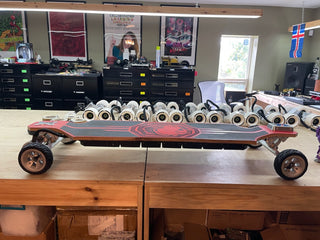When we designed and built the Defiant:One, we had one goal in mind: to build the best street board we could. Along the way we decided on a gear drive system that would make swapping wheels easy, and we accomplished that by using a common, standard interface for attaching the wheels. That interface is known as the Kegel hole pattern because of its origin with Orangatang Kegels, a popular longboard wheel often used on electric skateboards.
But what does any of this have to do with pneumatic wheels? Our board was designed for urethane wheels, and pretty much any compatible wheel will work up to around 120mm. Beyond that, the fixed ratio in the gear drive may deliver noticeably less torque, affecting the ride experience. Pneumatic wheels, often referred to as AT wheels or all terrain wheels, are traditionally anywhere from 6” to 8”, some even as big as 10”. Obviously wheels with tires that big are not going to work on our system, we would need a higher gear reduction and there’s no room for that in our gear boxes. It seemed as if we may never see an option allowing the use of pneumatic tires with our boards.
One night a message came in from an engineer at Hoyt St. They have been using a smaller machined aluminum wheel with street tires on their boards and thought a set would look pretty rad on our board, so they sent us a set that they had removed the pulleys from and had machined in a matching Kegel hole pattern for our drive system. The real magic though was that fully inflated the tire was only around 122mm.
The full set was immediately installed on one of our demo boards and tested. Expectations were reserved because there was still one factor working against us: pneumatics have a way of eating more battery than urethane wheels, which was one of the reasons we went with urethane. This has a lot to do with the energy spent working against the tire deformation, something that doesn’t happen on urethane. Fortunately lower profile tires are less bad about this, and when kept fully inflated the effect is even less noticeable.
Our initial tests found that they worked really well. Installation took all of 10 minutes, and street testing revealed a ton of grip, no tire tucking in the hard carves, and an even more comfortable ride. And to top it off, it seems the motors handled the slight increase in load just fine with a barely noticeable loss on torque. Of course the potential for higher speeds is there too. Bonus.
This was very good news because by now people were basically swarming our inboxes to ask about AT options. We finally had specs on an option that would work for street really well. Especially on terrible streets with bad pavement and even cobblestones, places urethane often suffers.
The problem was that now we needed them. So we decided to move forward with designing a rim that will work with our boards and the tires that Hoyt St uses and potentially other tires of a similar size and fit if they exist. We reached out to Boardnamics, the company that designed our trucks and drive system, and are currently waiting for the first prototypes to test.
The benefit won’t just be for people riding our boards, however. Because of the common wheel interface we’re using for compatibility with our gear drive system, anyone with a gear or belt drive board using the Kegel hole pattern will be able to use these wheels. That’s basically anyone with a DIY build or other modifiable board.
We’re very excited about this. It’s something our customers want, it’s something we want, and we’re happy to finally be able to make smaller pneumatic street wheels happen for our boards and maybe even yours.

